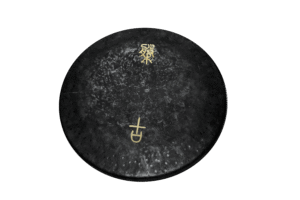Unlimited guide of singing bowl
Before reading
In our fast-paced modern world, the ancient art of sound healing is experiencing a remarkable renaissance. Among the most captivating instruments in this revival are singing bowls—mystical vessels that produce hauntingly beautiful tones capable of inducing deep states of relaxation and healing. Whether you’re a meditation practitioner, wellness enthusiast, or simply curious about alternative healing methods, this comprehensive guide will unlock the secrets of these extraordinary instruments.
Table of Contents
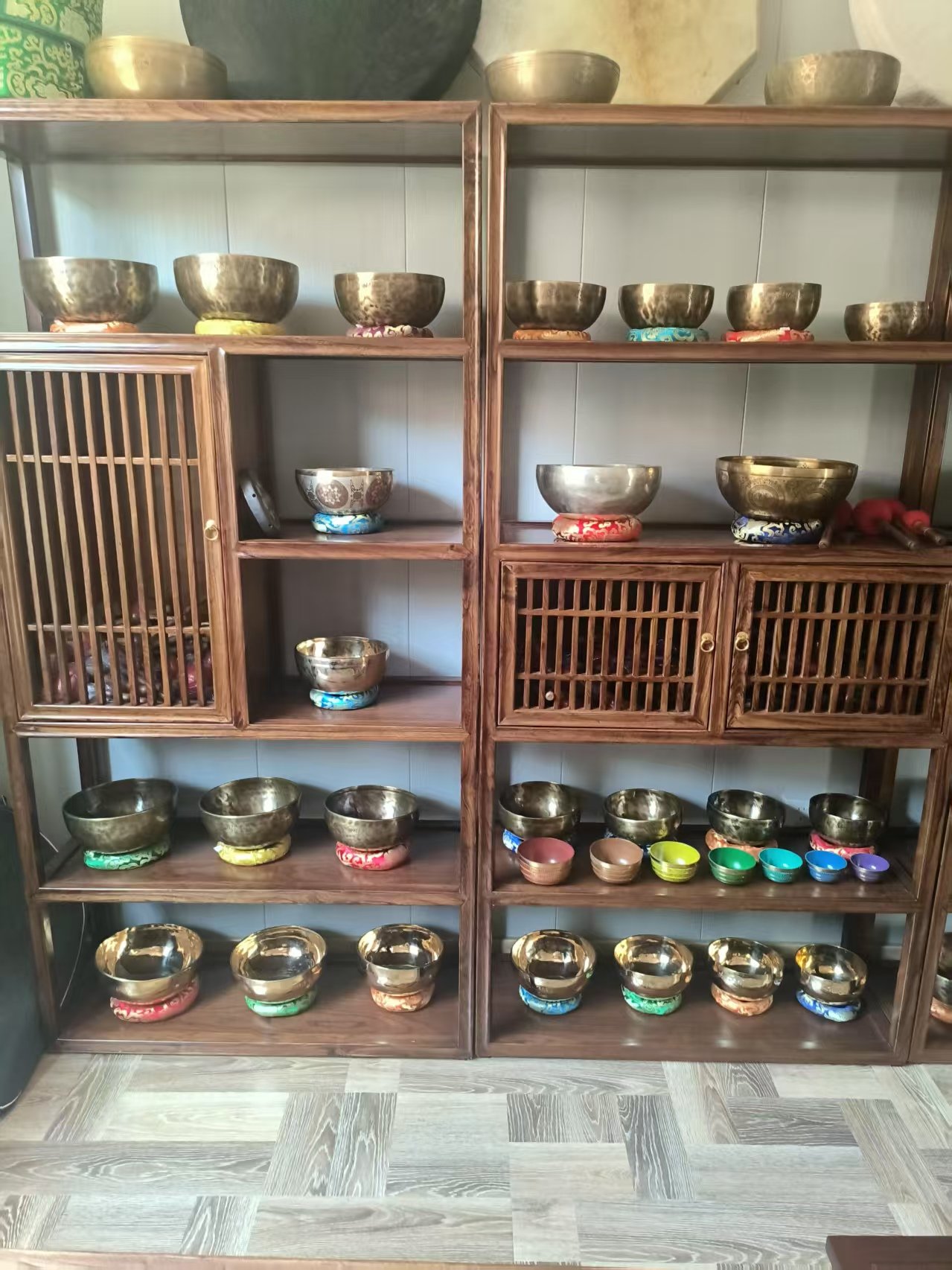
What Are Singing Bowls?
Singing bowls are bell-like vessels that produce sustained, resonant tones when struck or circled with a mallet. Unlike traditional bells that hang and swing, singing bowls rest on surfaces and create sound through vibration. The term “singing” refers to the continuous, pure tone they produce—a sound that seems to emerge from the bowl itself and can last for minutes with proper technique.
These instruments work on the principle of sympathetic vibration, where the bowl’s metal or crystal structure resonates at specific frequencies, creating sound waves that can be both heard and felt throughout the body. The resulting tones are rich in harmonics and overtones, creating a complex acoustic experience that engages multiple levels of consciousness.

The origins of singing bowls trace back over 2,000 years to the Himalayan regions of Tibet, Nepal, India, and surrounding areas. Buddhist monks traditionally used these sacred instruments for meditation, prayer, and ritual ceremonies. The bowls were considered so sacred that their creation and use were often shrouded in secrecy, with knowledge passed down through generations of artisans and spiritual practitioners.
In Tibetan culture, singing bowls were believed to facilitate communication with the divine and help practitioners achieve higher states of consciousness. The seven-metal composition traditionally used in authentic Tibetan bowls—gold, silver, mercury, copper, iron, tin, and lead—was thought to correspond to the seven planets known to ancient astronomers and the seven chakras of the human energy system.
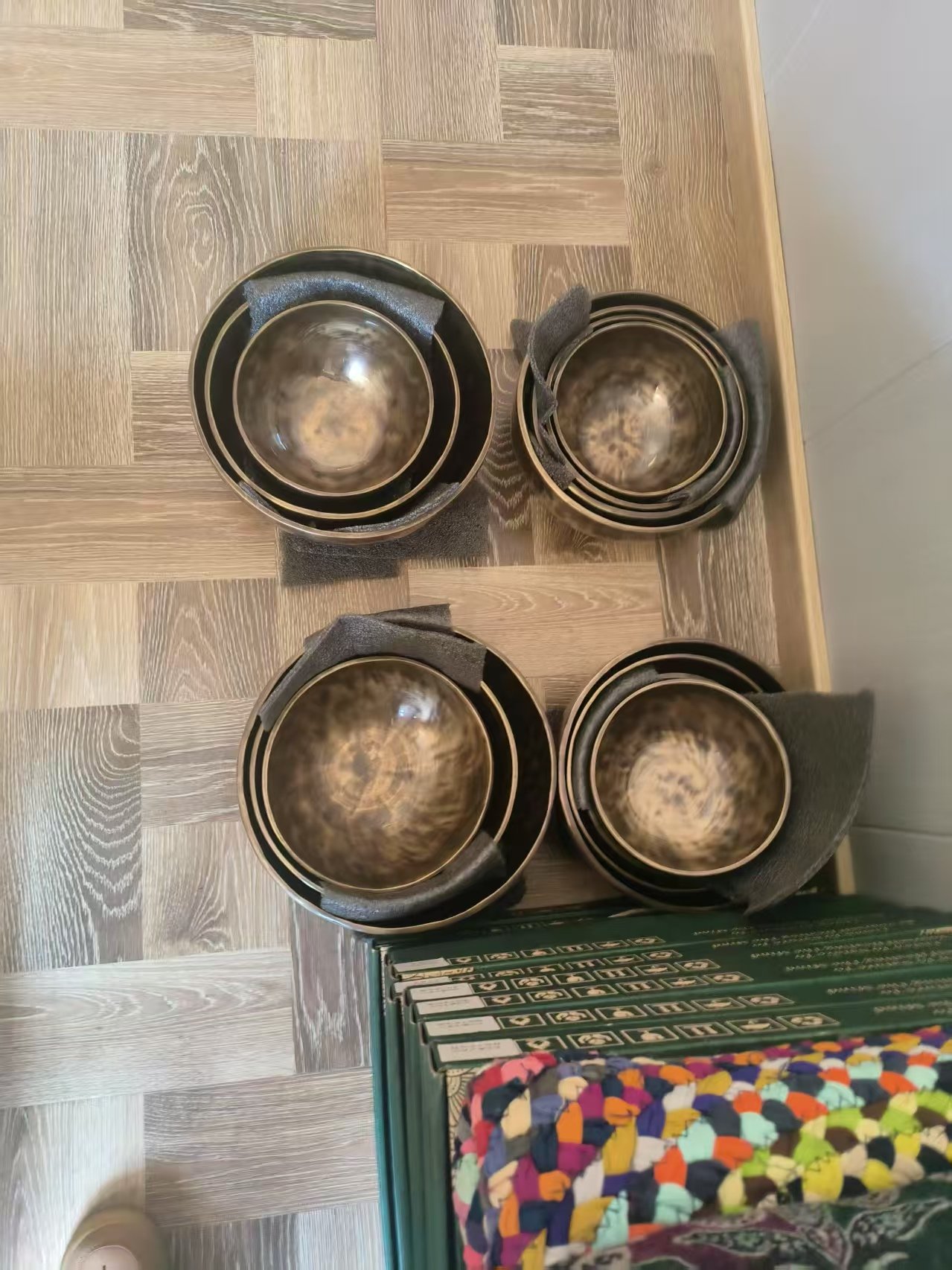
Modern science has begun to validate what ancient practitioners have long known: sound has profound effects on human physiology and psychology. When a singing bowl is activated, it produces vibrations that travel through air and physical matter, including the human body, which is approximately 70% water.
These vibrations operate on several levels:
Brainwave Entrainment: The consistent frequencies produced by singing bowls can guide brainwaves into alpha and theta states associated with deep relaxation, meditation, and healing.
Cellular Resonance: Sound vibrations can affect cellular metabolism and promote healing at the microscopic level.
Nervous System Regulation: The calming tones activate the parasympathetic nervous system, reducing stress hormones and promoting rest-and-digest responses.
Types of Singing Bowls
Tibetan Singing Bowls (Traditional Metal)
Hand-hammered vs Machine-made
Traditional Tibetan singing bowls fall into two primary categories based on their manufacturing process:
Hand-hammered bowls represent the authentic, ancient tradition. Skilled artisans heat metal alloys and hammer them into shape over several days, creating unique irregularities that contribute to complex harmonic patterns. Each bowl is one-of-a-kind, with subtle variations in thickness that create rich, layered tones. These bowls often command higher prices but offer superior sound quality and longevity.
Machine-made bowls are manufactured using modern casting or spinning techniques. While more affordable and consistent in appearance, they typically produce simpler tones with fewer harmonics. However, quality machine-made bowls can still provide excellent sound for meditation and healing practices.
Seven Metal Composition
Authentic Tibetan singing bowls traditionally contain seven metals, each corresponding to celestial bodies and chakras:
- Gold (Sun) – Solar plexus chakra
- Silver (Moon) – Sacral chakra
- Mercury (Mercury) – Throat chakra
- Copper (Venus) – Heart chakra
- Iron (Mars) – Root chakra
- Tin (Jupiter) – Third eye chakra
- Lead (Saturn) – Crown chakra
Modern bowls often use simplified alloys, typically bronze (copper and tin) or brass compositions, which are safer and more readily available while still producing beautiful tones.
Singing Bowl Benefits and Uses
The mechanisms behind these benefits include:
- Cortisol reduction: Sound therapy lowers stress hormone levels
- Heart rate variability: Improves cardiovascular health markers
- Muscle tension release: Vibrations help relax physical tension
- Mental clarity: Reduces racing thoughts and mental chatter
Deep Relaxation and Sleep Improvement
The sustained tones of singing bowls naturally guide the nervous system into parasympathetic dominance—the “rest and digest” state essential for healing and recovery. Regular practitioners report:
- Faster sleep onset
- Improved sleep quality and duration
- Reduced sleep medication dependence
- More refreshing rest periods
The key lies in the bowls’ ability to synchronize brainwaves with their consistent frequencies, promoting alpha and theta states associated with deep relaxation and REM sleep.
Pain Management and Physical Healing
Sound vibrations can provide natural pain relief through several mechanisms:
- Gate control theory: Sound signals compete with pain signals in neural pathways
- Endorphin release: Pleasurable sounds trigger natural pain-relieving chemicals
- Muscle relaxation: Vibrations reduce physical tension contributing to pain
- Circulation improvement: Enhanced blood flow promotes healing
Chronic pain sufferers often find singing bowl therapy particularly helpful for conditions like fibromyalgia, arthritis, and tension headaches.
Meditation and Spiritual Practices
Mindfulness Meditation Enhancement
Singing bowls serve as powerful anchors for mindfulness practice. The sustained tones provide a focal point that:
- Draws wandering attention back to the present moment
- Creates a sacred space for inner exploration
- Masks distracting environmental sounds
- Signals the beginning and end of meditation sessions
Many practitioners find that bowl sounds make meditation more accessible, especially when starting a regular practice.
Chakra Balancing and Energy Work
Each chakra corresponds to specific frequencies, and singing bowls can be selected or tuned to match these energy centers:
- Root Chakra (194.18 Hz): Grounding, survival, stability
- Sacral Chakra (210.42 Hz): Creativity, sexuality, emotions
- Solar Plexus (126.22 Hz): Personal power, confidence
- Heart Chakra (341.3 Hz): Love, compassion, connection
- Throat Chakra (384 Hz): Communication, truth, expression
- Third Eye (426.7 Hz): Intuition, wisdom, spiritual insight
- Crown Chakra (963 Hz): Divine connection, enlightenment
Sound Bath Therapy
Sound baths involve immersing participants in waves of sound from multiple singing bowls and other instruments. These sessions can:
- Facilitate deep meditative states
- Release emotional blockages
- Promote profound relaxation
- Create transformative experiences
- Build community through shared healing
Therapeutic Applications
Sound Healing Therapy
Professional sound healers incorporate singing bowls into comprehensive treatment protocols for various conditions:
- PTSD and trauma recovery: Gentle vibrations help process stored trauma
- Depression and mood disorders: Uplifting frequencies boost emotional well-being
- Addiction recovery: Meditation support and stress reduction
- Chronic illness support: Complementary therapy for medical treatment
Mental Health Support
Mental health professionals increasingly recognize sound therapy’s value:
- Anxiety disorders: Natural anxiety reduction without medication side effects
- Attention disorders: Improved focus and concentration
- Autism spectrum support: Sensory regulation and calming effects
- Dementia care: Familiar sounds can trigger positive memories and reduce agitation
Basic Playing Techniques
Striking Method
The striking method is the easiest way to begin working with singing bowls:
Preparation:
- Place the bowl on a stable, flat surface or cushion
- Hold the bowl gently in your non-dominant hand if it’s small enough
- Select an appropriate mallet (leather-wrapped for softer tones, wood for brighter sounds)
Technique:
- Hold the mallet like a pencil, about halfway down the handle
- Strike the bowl firmly but gently on the upper rim or side
- Allow the sound to develop and decay naturally
- Wait for the sound to fade before striking again
Tips for success:
- Strike at a 45-degree angle for optimal resonance
- Use consistent force to maintain even tones
- Experiment with different striking points for tonal variations
- Practice dynamic control from soft to loud strikes
Rimming/Singing Technique
The rimming technique produces the characteristic “singing” tone:
Setup:
- Place the bowl on a cushion or hold it steady in your palm
- Choose a wooden or suede-wrapped mallet
- Ensure the bowl rim is clean and dry
Technique:
- Start with a gentle strike to initiate vibration
- Immediately place the mallet against the rim
- Apply steady pressure while moving the mallet around the rim
- Maintain consistent speed and pressure
- Keep the mallet perpendicular to the rim
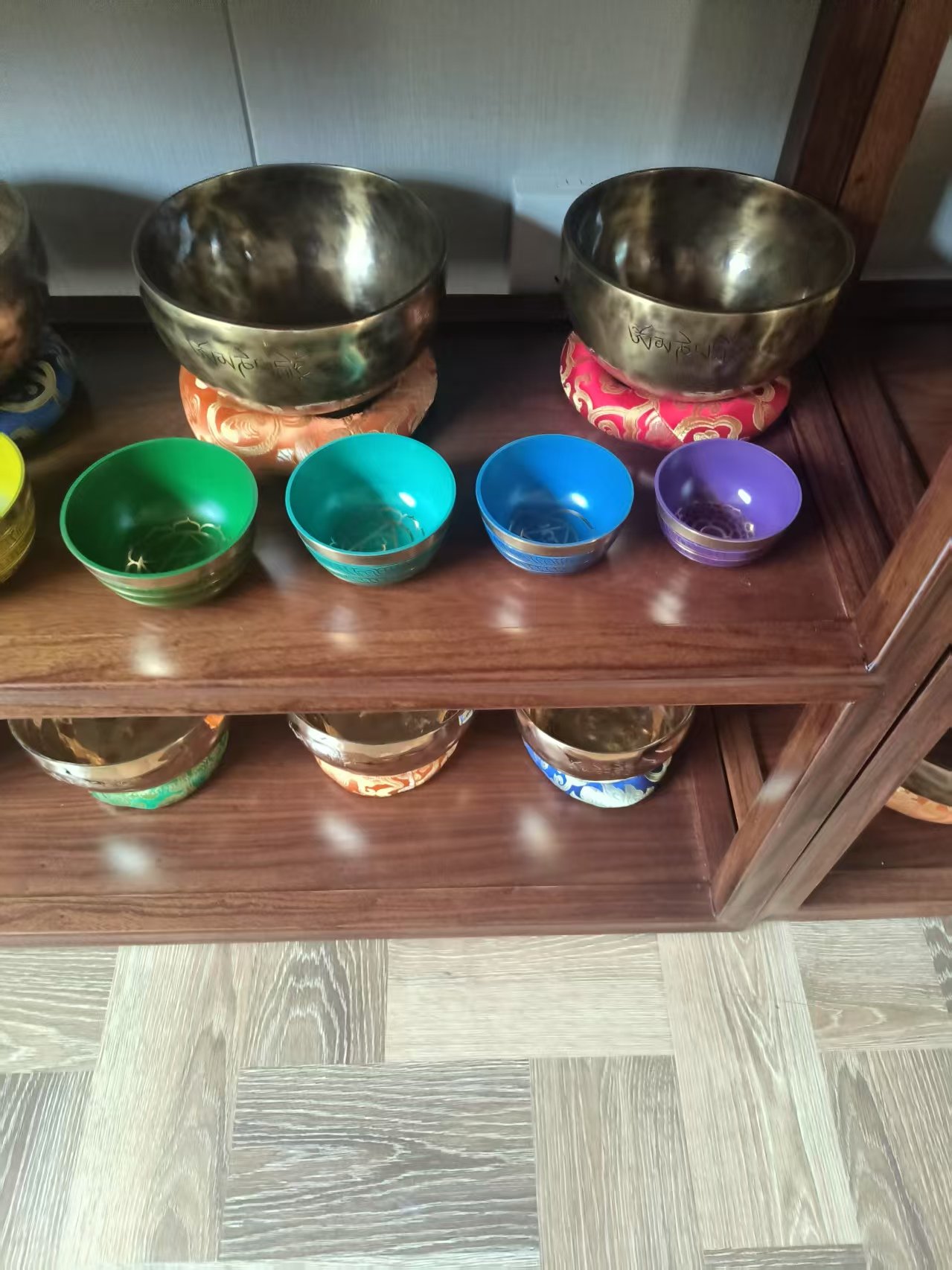
Proper Mallet Selection and Grip
Mallet choice dramatically affects your bowl’s sound:
Leather-wrapped mallets:
- Produce warm, mellow tones
- Excellent for gentle meditation sessions
- Less likely to damage bowl surfaces
- Ideal for beginners
Wooden mallets:
- Create brighter, more penetrating sounds
- Better for rimming larger bowls
- Require more skill to use effectively
- Preferred for therapeutic applications
Suede-wrapped mallets:
- Combine leather warmth with wooden projection
- Versatile for various playing styles
- Good grip for extended sessions
- Professional choice for sound healers
Multiple Bowl Combinations
Working with multiple bowls creates complex harmonic landscapes:
Harmonic intervals:
- Perfect fifth: Creates stable, pleasing harmonies
- Octaves: Reinforces fundamental frequencies
- Minor thirds: Adds emotional depth
- Perfect fourths: Builds tension and resolution
Sequential playing:
- Start with the lowest-pitched bowl
- Add higher pitches gradually
- Create rhythmic patterns
- Allow sounds to interact and blend
Water Bowls and Resonance Effects
Adding water to metal singing bowls creates unique effects:
Water benefits:
- Lowers the pitch slightly
- Creates visible vibration patterns on water surface
- Adds complexity to overtones
- Enhances projection in some bowls
Water techniques:
- Fill bowl 1/3 to 1/2 with clean water
- Strike gently to avoid splashing
- Observe water movement patterns
- Experiment with different water levels
Caution: Never add water to crystal bowls, as thermal shock can cause cracking.
How to Choose the Right Singing Bowl
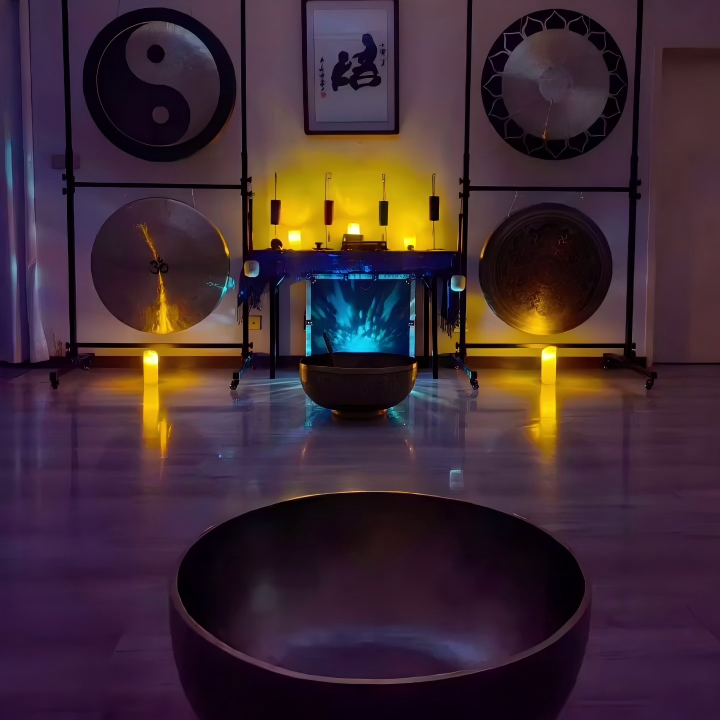
1. Factors to Consider
Size and Weight Preferences
Your ideal bowl size depends on several factors:
Personal considerations:
- Physical comfort: Can you hold and play the bowl comfortably?
- Living space: Do you have room for larger bowls?
- Transportation needs: Will you travel with your bowl?
- Volume requirements: Do you need quiet or powerful sounds?
Practical guidelines:
- Beginners: Start with 6-8 inch bowls for versatility
- Apartment dwellers: Choose smaller bowls to avoid noise complaints
- Therapeutic use: Larger bowls provide more physical sensation
- Children: Lightweight, smaller bowls are safer and easier to handle
Sound Quality and Frequency
Evaluating sound quality:
Sustain: High-quality bowls ring for 30+ seconds after striking
Clarity: Pure tones without distortion or wobbling
Harmonics: Complex overtones that develop over time
Volume: Appropriate projection for intended use
Beat frequencies: Gentle pulsing that adds richness
- High frequencies (400+ Hz): Stimulating, energizing, good for focus
- Mid frequencies (200-400 Hz): Balanced, versatile for general use
- Low frequencies (under 200 Hz): Grounding, relaxing, physically felt
Budget Considerations
Singing bowl prices vary dramatically based on several factors:
Budget ranges:
- Entry level ($30-100): Machine-made bowls, basic quality
- Mid-range ($100-500): Hand-hammered bowls, good sound quality
- Professional ($500-1500): Premium materials, exceptional craftsmanship
- Collector/Antique ($1500+): Rare, historical, or uniquely beautiful pieces
Value considerations:
- Sound quality vs. price ratio
- Longevity and durability
- Aesthetic appeal and craftsmanship
- Included accessories (mallets, cushions)
- Return policy and authenticity guarantees
2. Testing and Selecting Your Bowl
What to Listen For
Sound characteristics to evaluate:
Initial strike: Should be clear and immediate
Sustain development: Tone should bloom and evolve
Harmonic complexity: Listen for developing overtones
Volume consistency: Even projection throughout decay
Beating patterns: Gentle, pleasant interference patterns
Red flags:
- Harsh, metallic clanging sounds
- Immediate fade-out after striking
- Cracked or buzzing tones
- Inconsistent response to playing
Personal Resonance and Connection
Beyond technical qualities, your personal response matters:
Physical sensations:
- Do you feel the vibrations pleasantly in your body?
- Does the sound create a sense of relaxation?
- Are there any uncomfortable physical reactions?
Emotional response:
- Does the sound move you emotionally?
- Do you feel drawn to continue listening?
- Does it complement your meditation practice?
Intuitive connection:
- Trust your first impression
- Consider how the bowl looks and feels
- Notice any immediate sense of “rightness”
3. Buying Guide: Where and What to Buy
Reputable Sellers and Brands
Established retailers:
- Silent Mind Singing Bowls: Wide selection, good quality control
- DharmaShop: Authentic Tibetan imports, fair trade practices
- Crystal Tones: Premium crystal bowl manufacturer
- Ohm Store: Comprehensive sound healing inventory
What to look for in sellers:
- Detailed product descriptions and specifications
- Clear return and exchange policies
- Customer reviews and testimonials
- Educational resources and support
- Authenticity guarantees
Red Flags to Avoid
Warning signs of low-quality sellers:
- Vague or missing product information
- Unusually low prices for claimed quality
- No return policy or customer service
- Stock photos without actual product images
- Claims about “ancient artifacts” for new bowls
Quality red flags:
- Visible cracks, dents, or imperfections
- Inconsistent thickness or asymmetry
- Poor-quality mallets or accessories
- Fake aging or artificial patina
- Unrealistic claims about age or origin
Online vs In-Person Purchasing
Online advantages:
- Wider selection and competitive pricing
- Customer reviews and detailed specifications
- Easy comparison shopping
- Convenient delivery
Online disadvantages:
- Cannot test sound before purchasing
- Shipping risks for fragile items
- Difficulty assessing true quality
- Return shipping costs
In-person advantages:
- Test multiple bowls before deciding
- Expert guidance from knowledgeable staff
- Immediate satisfaction and no shipping delays
- Support local businesses
In-person disadvantages:
- Limited local selection
- Potentially higher prices
- Time investment for shopping
Classic frequency bundle
8 note Full Octave Set
- Notes and Octaves: C4 – D4 – E4 – F4 – G4 – A4 – B4 and C5 form a complete octave
- Purpose: Create full musical compositions and complex harmonies. Offer unlimited tonal combinations and chord progressions. Enable seamless transitions between frequencies for fluid sound experiences
7 note Major Harmony Set
- Notes and Octaves: C4 – D4 – E4 – F4 – G4 – A4 – B4
- Purpose: To create a bright, positive, harmonious atmosphere, to elevate energy, and to promote joy and openness. Suitable for daily practice, beginners, and group meditation.
7-Note Minor Introspection Set
- Notes and Octaves: A3 – B3 – C4 – D4 – E4 – F4 – G4
- Purpose: Creates a soft, deep, introspective atmosphere suitable for deep relaxation, emotional exploration and meditation.
5-Note Harmonic Healing Set
- Notes and Octaves: C4 – D4 – E4 – G4 – A4
- Purpose: The sound is harmonious and conflict-free, making it ideal for children, those with pitch sensitivity, or anyone seeking a purely relaxing and healing atmosphere. Often used for improvisation and deep meditation.
Multi-Octave Energy Expansion Set
- Notes and Octaves: C4 – B4 and C5 – B5
- Purpose: Creates richer, more three-dimensional sound layers, suitable for larger sound baths or healing sessions requiring a wide frequency range.
Heart-Opening Light Set
- Notes and Octaves:
C Major Triad: C4 – E4 – G4
F Major Triad: F4 – A4 – C5
G Major Triad: G4 – B4 – D5
- Purpose: Creates a bright, positive, mood-enhancing atmosphere that promotes openness, joy, and confidence.
Introspective Healing Set
- Notes and Octaves:
A minor triad: A3 – C4 – E4
D minor triad: D4 – F4 – A4
E minor triad: E4 – G4 – B4
- Purpose: Creates a soft, deep, introspective atmosphere suitable for emotional release, deep relaxation and meditation, sometimes used for processing grief or inner work.
Rich Resonance Set
- Notes and Octaves:
C Major Seventh Chord: C4 – E4 – G4 – B4
D Minor Seventh Chord: D4 – F4 – A4 – C5
- Purpose: Increases the richness and complexity of the sound, creating a more immersive and “full” sound field, often used to guide deep meditation or specific emotional states.
Sound of Joy Set
- Notes and Octaves:
C4 – E4 – G4 – B4
- Purpose: Lifts mood, brings positivity, brightness and upliftment, and relieves low moods.
Waves of Serenity Set
- Notes and Octaves:
A3 – C4 – E4 – G4
- Purpose: Induce a state of deep relaxation, reduce stress, and promote calmness and tranquility.
Cleansing & Renewal Set
- Notes and Octaves:
F4 – A4 – C5 – E5
- Purpose: Clears negative, stagnant energy from a person’s aura or space, bringing freshness and vitality.
Singing Bowls and Other Sound Healing Instruments
Singing Bowls vs Tuning Forks
Singing bowls advantages:
- Longer sustain and decay times
- Multiple harmonic frequencies simultaneously
- Greater volume and room-filling presence
- More varied playing techniques available
- Visual and tactile engagement
Tuning forks advantages:
- Precise, consistent frequencies
- Portable and nearly indestructible
- Specific therapeutic applications
- Easy to learn and use
- Lower cost for professional sets
Best uses comparison:
- Singing bowls: Meditation, relaxation, group sessions, ambient sound
- Tuning forks: Chakra work, acupuncture points, specific frequency therapy, clinical applications
Singing Bowls vs Gongs
Singing bowls advantages:
- More controllable volume levels
- Intimate, personal-scale instruments
- Easier to play with consistent results
- Better for beginners and home use
- More portable and storage-friendly
Gongs advantages:
- Dramatic dynamic range and power
- Complex, evolving soundscapes
- Professional sound bath centerpieces
- Greater physical impact and presence
- Wider frequency spectrum
Choosing between them:
- Singing bowls: Personal practice, small groups, budget consciousness
- Gongs: Professional sound healing, large spaces, dramatic experiences
Singing Bowls vs Wind Chimes
Singing bowls advantages:
- Intentional, controlled sound creation
- Sustained tones for meditation focus
- Consistent, predictable acoustics
- Active engagement and participation
- Indoor use without weather dependence
Wind chimes advantages:
- Passive, ambient sound generation
- Natural environmental integration
- Outdoor durability and weather resistance
- Continuous gentle sound presence
- No technique required
Complementary uses:
- Wind chimes for ambient environmental sound
- Singing bowls for focused meditation and healing work
- Combined use for complete sound environments
Building a Sound Healing Collection
Starting collection priorities:
- Foundation bowl: One high-quality 7-8 inch Tibetan bowl
- Crystal addition: One clear quartz crystal bowl for contrast
- Size variety: Add smaller (5-6 inch) and larger (9-10 inch) bowls
- Frequency diversity: Include different pitches and harmonic relationships
Advanced collection expansion:

- Chakra sets: Seven bowls tuned to chakra frequencies
- Cultural variety: Bowls from different traditions and regions
- Material exploration: Various metal alloys and crystal types
- Complementary instruments: Tingsha bells, dorje, wooden mallets
Budget-friendly building strategies:
- Start with one excellent bowl rather than several mediocre ones
- Buy quality mallets and accessories to maximize existing bowls
- Attend sound healing workshops to try different instruments
- Consider used or consignment instruments from reputable sources
Singing Bowl Maintenance and Care
Daily Maintenance
Proper daily care extends your bowl’s life and maintains optimal sound quality:
After each use:
- Wipe down with a soft, dry cloth
- Remove fingerprints and moisture
- Check for any new damage or wear
- Store in designated safe location
Weekly cleaning routine:
- Dust thoroughly with microfiber cloth
- Polish gently with appropriate cleaner
- Inspect mallet condition
- Clean storage area
Deep Cleaning Methods
For metal bowls:
Materials needed:
- Warm water
- Mild dish soap
- Soft-bristled brush
- Microfiber cloths
- Metal polish (optional)
Process:
- Rinse with warm water
- Apply small amount of mild soap
- Gently scrub with soft brush
- Rinse thoroughly
- Dry immediately and completely
- Polish if desired for shine
Proper Storage and Handling
Storage solutions:
Individual storage:
- Padded carrying cases for travel
- Dedicated shelves with cushioning
- Ring cushions to prevent rolling
- Climate-controlled environments
Multiple bowl storage:
- Compartmentalized cases
- Padding between bowls
- Separate small and large bowls
- Easy access for regular use
Handling guidelines:
- Always use both hands for larger bowls
- Lift from the base, not the rim
- Avoid stacking bowls directly
- Keep away from hard surfaces
- Supervise children during use

Protecting Your Investment
Insurance considerations:
- Document bowls with photos and appraisals
- Include in homeowner’s/renter’s insurance
- Consider separate coverage for valuable pieces
- Keep purchase receipts and authenticity certificates
Environmental protection:
- Maintain stable temperature and humidity
- Avoid direct sunlight exposure
- Protect from dust and pollutants
- Monitor for pest damage (especially for antiques)

When to Replace Your Bowl
Signs it’s time for replacement:
Structural damage:
- Visible cracks that affect sound
- Significant dents or deformation
- Loose or damaged rim sections
- Internal damage from drops
Sound degradation:
- Dramatic change in tone quality
- Reduced sustain or volume
- Development of unwanted buzzing
- Loss of harmonic complexity
Safety concerns:
- Sharp edges from damage
- Instability when placed
- Lead content concerns in very old bowls
- Allergic reactions to materials
Most Popular Questions
While singing bowls are generally very safe, certain considerations apply:
Physical considerations:
- Pregnancy: Some practitioners avoid sound therapy during early pregnancy, though research shows no specific risks
- Heart conditions: Those with pacemakers should consult physicians before sound therapy
- Hearing sensitivity: People with hyperacusis or misophonia may find bowls overwhelming
- Metal allergies: Rare but possible reactions to bowl materials
Emotional considerations:
- Sound therapy can sometimes trigger emotional releases
- Those with trauma histories may need gentle introduction
- Supervision recommended for first-time users with mental health conditions
Age considerations:
- Children can safely use singing bowls with supervision
- Elderly individuals may have enhanced sensitivity requiring gentler approaches
- No upper or lower age limits for appropriate use
Frequency recommendations vary by purpose:
Daily meditation practice:
- 10-20 minutes daily provides cumulative benefits
- Consistency matters more than duration
- Morning use can set positive intentions for the day
- Evening use supports relaxation and sleep preparation
Therapeutic applications:
- 2-3 sessions per week for stress management
- Daily use during acute stress periods
- As needed for pain management or emotional support
- Follow practitioner guidance for specific conditions
Signs of overuse:
- Emotional overwhelm or increased sensitivity
- Fatigue rather than energization after sessions
- Decreased response to the sounds
- Physical discomfort from prolonged exposure
Material quality differences:
Expensive bowls typically feature:
- Hand-forged construction with traditional techniques
- High-quality metal alloys or pure crystal materials
- Superior acoustic properties and harmonic complexity
- Exceptional craftsmanship and attention to detail
- Authentic cultural provenance and artisan signatures
Inexpensive bowls often have:
- Machine manufacturing with cost-cutting shortcuts
- Lower-grade materials or simplified alloy compositions
- Basic acoustic properties with limited harmonic development
- Mass production quality control variations
- Generic or unclear origin information
Sound quality differences:
Premium bowls deliver:
- Long sustain times (45+ seconds)
- Complex, evolving harmonic structures
- Consistent response to various playing techniques
- Rich, full-bodied tones with depth and character
- Minimal distortion or unwanted noise
Budget bowls typically provide:
- Shorter sustain times (15-30 seconds)
- Simpler tonal structures with fewer harmonics
- Variable response requiring technique adjustment
- Basic but adequate sound for meditation use
- Possible minor imperfections or inconsistencies
Value considerations:
- Expensive doesn't always mean better for your specific needs
- Many mid-range bowls offer excellent value for most users
- Consider your experience level and intended use
- Factor in longevity and resale value for investment decisions
- Personal preference and connection matter more than price alone
Benefits for children:
- Improved focus and attention span
- Emotional regulation and calming
- Sleep quality enhancement
- Creative expression and exploration
- Mindfulness and body awareness development
Age-appropriate guidelines:
- Ages 3-6: Supervised use only, shorter sessions (5-10 minutes)
- Ages 7-12: Can learn basic techniques with guidance
- Ages 13+: Can use independently with proper instruction
Safety considerations:
- Choose smaller, lighter bowls for easier handling
- Teach proper striking technique to prevent damage
- Supervise initial sessions to ensure comfort
- Watch for signs of overstimulation or discomfort
Educational applications:
- Sound exploration and musical education
- Cultural learning about Eastern traditions
- Science lessons about vibration and frequency
- Emotional intelligence and self-regulation skills



